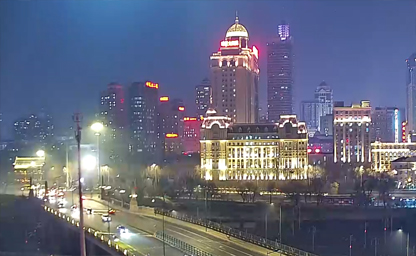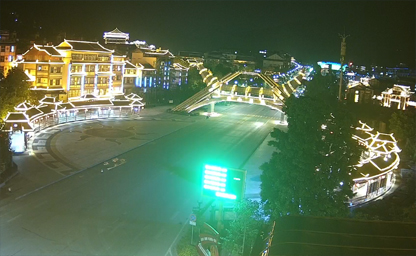
Arch of the Orient
It’s a large sculpture that is usually passed on the way to the primary ferry terminal

It’s a large sculpture that is usually passed on the way to the primary ferry terminal

A remarkable architectural landmark but also a witness to the city's long-standing history

The small town lies cradled beneath a cerulean sky and surrounded by verdant mountains, creating a picture‑perfect scene

Spans the estuary of Praia Grande Bay, linking the Macau Peninsula to Taipa Island

Stunning skyline, bustling harbour, and Causeway Bay
China, a vast and culturally rich country stretching across mountains, deserts, megacities, and centuries-old villages, offers an incredible variety of experiences. Thanks to modern technology, people around the world can explore these landscapes and communities in real time through online live cameras. From the bustling streets of Shanghai to the peaceful temples of Tibet, live cams are becoming a popular way to discover China virtually. These cameras are not just tools for travel inspiration—they're also used for weather monitoring, education, cultural appreciation, and even wildlife observation. The demand for live cameras in China has grown rapidly as more travelers, students, and curious minds look for real-time views of life across this immense and fascinating country.
In major cities like Beijing, Shanghai, Guangzhou, and Chengdu, live webcams give 24/7 access to some of the most iconic urban environments in the world. In Shanghai, city cameras capture the skyline of Pudong, including the famous Oriental Pearl Tower and Shanghai Tower. These cameras are especially popular during the night, when the city lights reflect on the Huangpu River, creating an unforgettable view. Street-level cams in areas like Nanjing Road or the French Concession show busy shopping streets, cafes, and parks, giving viewers an authentic sense of daily life. In Beijing, live feeds from Tiananmen Square and the Forbidden City attract millions of viewers who want to witness important state events, national holidays, and the gentle rhythm of morning activities such as Tai Chi practice and ceremonial flag-raising events.
Travelers and nature lovers are drawn to live cameras positioned in China's breathtaking natural sites. The Great Wall, one of the most visited landmarks in the world, has several cameras, especially around Badaling and Mutianyu sections. These webcams show real-time weather conditions and provide panoramic views of the wall stretching across mountain ridges. During the fall season, the changing leaves make for especially beautiful scenes. Another remarkable destination is Zhangjiajie National Forest Park in Hunan Province. Live feeds from this area show towering sandstone pillars often shrouded in mist, a landscape that inspired the floating mountains in popular movies. Watching these views in real time gives a new level of appreciation for the natural wonders of China.
In southern China, live cameras focus on the dramatic landscapes around Guilin and the Li River. These feeds show traditional bamboo rafts floating past karst peaks, as well as scenes of local life in the nearby villages. Early morning mists and sunset reflections on the river make these live streams some of the most popular among travelers planning their trips. In Tibet, live cams placed near the Potala Palace in Lhasa give breathtaking views of one of Buddhism’s most sacred locations. The surrounding Himalayan landscape, prayer flags fluttering in the wind, and the serene atmosphere of temple life can all be seen in real time, offering viewers a peaceful and inspiring experience from thousands of kilometers away.
One of the most beloved live streams in China comes from the panda enclosures at the Chengdu Research Base of Giant Panda Breeding. These cameras offer real-time views of baby pandas napping, playing, and eating bamboo. Viewers from all around the world tune in daily to watch these gentle animals, making this one of the most visited wildlife webcams globally. In other parts of the country, live cameras are used in national parks and nature reserves, such as the Zhalong Wetlands in the northeast. These streams allow viewers to watch red-crowned cranes and other bird species during migration seasons, providing important educational content and raising awareness for conservation efforts.
China's rich cultural heritage is also highlighted through webcams in ancient towns and traditional neighborhoods. Places like Wuzhen, Tongli, and Lijiang are known for their historic architecture, narrow canals, and stone bridges. Live feeds from these locations show local residents going about their daily routines, shopkeepers opening their stores, and visitors strolling through the cobbled streets. These live cams provide an authentic and unfiltered view of life in traditional China and are popular with viewers interested in heritage, architecture, and cultural tourism.
Live cameras in religious and spiritual locations allow people around the world to observe sacred moments. At Mount Emei and other holy Buddhist mountains, temple webcams show rituals, monks in prayer, and breathtaking views from mountaintop monasteries. These scenes are especially peaceful at sunrise and sunset, when the mountains are bathed in soft light. In Shaolin Temple, known as the birthplace of Chinese martial arts, live streams sometimes show martial arts training sessions and ceremonies, offering a rare look into ancient traditions that still thrive today.
China’s advanced infrastructure is also a point of interest for live camera viewers. At major transportation hubs like Beijing Daxing International Airport or Shanghai Hongqiao Railway Station, cameras show the smooth operation of high-speed trains and flights. Viewers can watch trains arriving and departing within minutes, highlighting the country’s efficient public transportation systems. These feeds are particularly useful for those interested in engineering, logistics, or planning travel within China. During peak seasons such as Spring Festival, the volume of activity on these streams increases significantly as millions of people travel across the country.
Weather and environment monitoring is another important use of live webcams in China. In cities like Beijing and Harbin, live cameras provide current views of sky conditions, air quality, and seasonal changes. Harbin’s camera feeds during winter months showcase the famous Ice and Snow Festival, with towering sculptures and colorful light displays made entirely of ice. These streams are not only visually stunning but also useful for people planning to attend major events or festivals. Along coastal areas, cameras monitor typhoon activity and sea conditions, making them essential tools for safety and emergency planning.
Access to these cameras is often available through travel websites, local tourism boards, or streaming platforms that feature curated collections of Chinese webcams. Social media apps also help spread awareness of these live streams, with many people sharing clips or recommending certain times to tune in. The technology behind these webcams continues to improve, with many now offering high-definition video, 360-degree rotation, and time-lapse features that compress hours of footage into short, beautiful clips.
For those exploring China virtually, live cameras offer an unmatched sense of presence. You can witness the first light over Hangzhou’s West Lake, the busy markets of Xi’an, or the serenity of Yunnan’s rice terraces without booking a flight. As travel planning becomes more digital, these real-time windows into China serve both as inspiration and a valuable resource for getting to know the country in a deeper, more personal way.
A helpful tip for travelers or cultural explorers: tune in to temple webcams during major Chinese festivals like Lantern Festival or Mid-Autumn Festival to experience traditional rituals, music, and beautiful decorations live. And here’s an interesting fact: one of the most-watched live streams in China is not of a tourist site, but of a rural village in Yunnan, where viewers tune in to watch the slow, peaceful rhythm of village life—a perfect reminder that sometimes the quietest places tell the most powerful stories.
China’s history is one of the most fascinating and complex in the world, stretching back more than 5,000 years. From ancient dynasties to modern global power, this East Asian giant has shaped and been shaped by a dynamic mix of culture, politics, and innovation. The early Chinese civilization emerged along the fertile banks of the Yellow River, where early farming communities gave rise to organized societies like the Xia, Shang, and Zhou dynasties. These early dynasties laid the groundwork for what would become the Chinese empire, with developments in bronze working, written language, and religious practices that can still be seen in Chinese traditions today.
The imperial era began in earnest with the Qin Dynasty in 221 BCE. It was during this period that China was first unified under Emperor Qin Shi Huang, who also began construction of the first version of the Great Wall of China — now one of the most visited landmarks in the world. The Qin were succeeded by the Han Dynasty, which is often considered a golden age of Chinese culture, science, and trade. The Han expanded the Silk Road, facilitating international trade and cultural exchange between China, Central Asia, and even the Roman Empire.
Over the centuries, China would witness the rise and fall of powerful dynasties such as the Tang, Song, Yuan (Mongol-led), Ming, and Qing. Each left its mark on Chinese architecture, philosophy, and governance. The Ming Dynasty, for example, was responsible for constructing much of the Great Wall as it appears today and for commissioning the famous voyages of Admiral Zheng He across the Indian Ocean. The Qing Dynasty, China’s last imperial house, ruled from 1644 to 1912, a period characterized by territorial expansion and both internal stability and external pressures from Western powers.
The early 20th century marked a dramatic shift in Chinese history with the fall of the Qing and the rise of the Republic of China. Political turmoil, warlordism, and the Japanese invasion during World War II led to decades of unrest. In 1949, after a prolonged civil war, the Communist Party of China led by Mao Zedong established the People’s Republic of China. This ushered in a new era marked by sweeping reforms, the Cultural Revolution, and, later, economic liberalization under Deng Xiaoping. Today, China is a major player on the global stage, a fascinating mix of ancient traditions and futuristic cities that continues to evolve rapidly.
China’s climate is as diverse as its landscapes. This vast country spans over 5,000 kilometers from east to west and 5,500 kilometers from north to south, resulting in several distinct climate zones that influence everything from regional cuisine to traditional clothing. Northern China experiences a continental climate, with cold, dry winters and hot summers. Beijing, the nation’s capital, often sees snow in winter and temperatures soaring above 30°C (86°F) in July and August.
Southern China, in contrast, has a subtropical climate that brings warm, humid conditions most of the year. Cities like Guangzhou and Shenzhen enjoy milder winters and hot, rainy summers, especially during the East Asian monsoon season. The monsoon typically lasts from May to September and is vital for agriculture, particularly the cultivation of rice in southern provinces.
Western China, which includes parts of the Tibetan Plateau and the deserts of Xinjiang, tends to be arid and cold. This region sees vast temperature differences between day and night. Tibet, known as “the Roof of the World,” has a tundra-like climate with long, harsh winters and short, cool summers. Meanwhile, the northwest deserts, including the Gobi and Taklamakan, experience extreme dryness and high daytime temperatures.
The southeastern coast, including cities like Shanghai and Hangzhou, has a humid subtropical climate influenced by the Pacific Ocean. Typhoons occasionally hit this region during the summer months, bringing heavy rains and strong winds. Travelers visiting China are advised to check the local weather forecasts and pack accordingly, as the difference between climates in regions like Harbin in the northeast and Kunming in the southwest can be dramatic even during the same season.
Spring and autumn are often considered the best times to visit China. These seasons offer more moderate temperatures and clearer skies, making it ideal for exploring both natural wonders and historical landmarks. From cherry blossoms in Wuhan to colorful autumn foliage on the Great Wall, the changing seasons add another layer of beauty to this already captivating country.
China’s geography is among the most varied and breathtaking on Earth. With landscapes ranging from the towering Himalayas to lush river valleys and sweeping deserts, the country offers something for every type of traveler or geography enthusiast. Covering approximately 9.6 million square kilometers, China is the third-largest country in the world by area, following Russia and Canada.
To the west lies the rugged terrain of the Tibetan Plateau, home to Mount Everest, the highest peak in the world at 8,848 meters (29,029 feet) above sea level. This region, shared with Nepal, is often visited by trekkers, mountaineers, and spiritual seekers exploring Tibetan Buddhist monasteries. The plateau is also the source of many of Asia’s great rivers, including the Yangtze, Mekong, and Yellow Rivers, which provide water to billions across the continent.
In the north, the vast grasslands of Inner Mongolia stretch across the horizon, interspersed with sand dunes and ancient steppe routes once traveled by Mongol warriors. To the east, the land slopes down into fertile plains and river basins. The North China Plain is one of the most densely populated and agriculturally productive regions in the country, historically referred to as the “cradle of Chinese civilization.”
Southern China is a paradise of karst landscapes, winding rivers, and subtropical forests. The Li River near Guilin is particularly famous for its surreal limestone hills, depicted in traditional Chinese paintings and now a favorite spot for scenic boat cruises. Coastal regions like Fujian and Zhejiang feature rugged cliffs, beautiful islands, and bustling ports that play a major role in global trade.
China also boasts vast desert regions, such as the Gobi and Taklamakan, which occupy the northwest. These deserts are not just barren wastelands — they are full of historical significance, with ancient Silk Road cities like Dunhuang and Turpan offering glimpses into the past. The unique geography of these deserts has preserved ancient murals, manuscripts, and cave temples that attract historians and tourists alike.
Another geographical marvel is the Yangtze River, the longest river in Asia and third-longest in the world. Flowing over 6,300 kilometers, it serves as a vital waterway for transportation, agriculture, and hydroelectric power. The Three Gorges Dam, located on the Yangtze, is the world’s largest hydroelectric power station and a modern engineering marvel that draws visitors from around the globe.
China’s varied geography has not only shaped its culture and economy but also its biodiversity. The country is home to unique species like the giant panda, golden snub-nosed monkey, and South China tiger, many of which are found in specially protected natural reserves.
Travelers to China are rewarded with a sensory feast of landscapes, from the icy beauty of Harbin’s Ice Festival to the tropical shores of Hainan Island. Whether you’re hiking the Dragon’s Backbone Rice Terraces or sailing down the Yangtze, China’s geographic diversity guarantees an unforgettable journey.
For those planning to explore this vast and multifaceted country, here’s a travel tip: train travel is one of the best ways to witness China’s changing landscapes up close, with high-speed rail lines connecting major cities and scenic routes offering stunning views. And here’s an interesting fact: China is home to 56 recognized ethnic groups, and many live in remote, geographically distinct regions—adding even more cultural richness to this incredible destination.